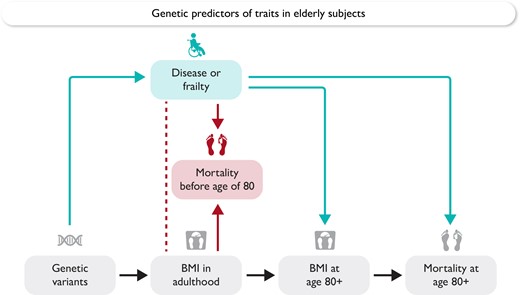-
Views
-
Cite
Cite
Stephen Burgess, Ang Zhou, Genetic predictors of traits in elderly subjects: risk of survival bias and reverse causation, European Heart Journal, Volume 45, Issue 24, 21 June 2024, Pages 2155–2157, https://doi.org/10.1093/eurheartj/ehae295
Close - Share Icon Share

Schematic diagram indicating potential biasing causal pathways. For a valid Mendelian randomization analysis, all causal pathways from the genetic variants to the outcome must pass via the exposure (black path). Genetic variants affecting body mass index (BMI) at age 80+ via a disease or frailty mechanism (blue paths) may induce bias from reverse causation. Genetic variants influencing mortality before age 80 (red path) may associate with BMI at age 80+ by survival bias, a particular example of selection bias (also called collider bias). As mortality before age 80 is a common effect of BMI on adulthood and disease, conditioning on survival until 80 will induce an association between BMI and disease (indicated by the red dashed line). In both cases, there may be a pathway from the genetic variants to the outcome that does not pass via the exposure





